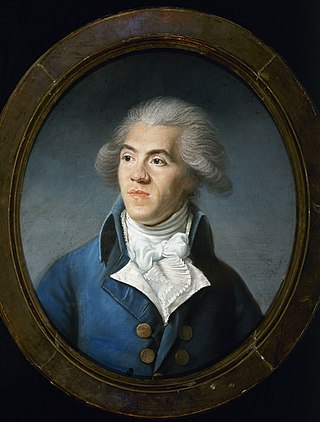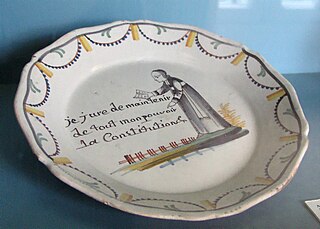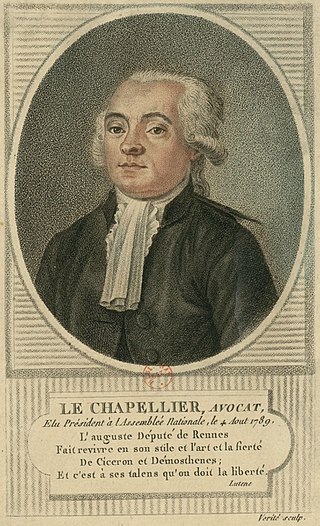
The French Revolution was a period of political and societal change in France that began with the Estates General of 1789, and ended with the coup of 18 Brumaire on November 1799 and the formation of the French Consulate. Many of its ideas are considered fundamental principles of liberal democracy, while its values and institutions remain central to modern French political discourse.

Honoré Gabriel Riqueti, Count of Mirabeau was a French writer, orator, statesman and a prominent figure of the early stages of the French Revolution.

Antoine Pierre Joseph Marie Barnave was a French politician, and, together with Honoré Mirabeau, one of the most influential orators of the early part of the French Revolution. He is most notable for correspondence with Marie Antoinette in an attempt to set up a constitutional monarchy and for being one of the founding members of the Feuillants.

The royal Flight to Varennes during the night of 20–21 June 1791 was a significant event in the French Revolution in which King Louis XVI of France, Queen Marie Antoinette, and their immediate family unsuccessfully attempted to escape from Paris to Montmédy, where the King wished to initiate a counter-revolution by joining up with royalist troops. They escaped as far as the small town of Varennes-en-Argonne, where they were arrested after being recognized at their previous stop in Sainte-Menehould.

The National Constituent Assembly was a constituent assembly in the Kingdom of France formed from the National Assembly on 9 July 1789 during the first stages of the French Revolution. It dissolved on 30 September 1791 and was succeeded by the Legislative Assembly.

The Society of the Friends of the Constitution, renamed the Society of the Jacobins, Friends of Freedom and Equality after 1792 and commonly known as the Jacobin Club or simply the Jacobins, was the most influential political club during the French Revolution of 1789. The period of its political ascendancy includes the Reign of Terror, during which well over 10,000 people were put on trial and executed in France, many for political crimes.

The following is a timeline of the French Revolution.

The French Revolution was a period in the history of France covering the years 1789 to 1799, in which republicans overthrew the Bourbon monarchy and the Roman Catholic Church in France perforce underwent radical restructuring. This article covers the one-year period from 1 October 1791 to September 1792, during which France was governed by the Legislative Assembly, operating under the French Constitution of 1791, between the periods of the National Constituent Assembly and of the National Convention.

The Civil Constitution of the Clergy was a law passed on 12 July 1790 during the French Revolution, that caused the immediate subordination of most of the Catholic Church in France to the French government. As such, a schism was created, resulting in a French Catholic Church loyal to the Papacy, and a "constitutional church" subject to the French state. The schism was not fully resolved until 1801. King Louis XVI ultimately yielded to the measure after originally opposing it.

Isaac René Guy Le Chapelier was a French jurist and politician of the Revolutionary period.

The French Constitution of 1791 was the first written constitution in France, created after the collapse of the absolute monarchy of the Ancien Régime. One of the basic precepts of the French Revolution was adopting constitutionality and establishing popular sovereignty.

The insurrection of 10 August 1792 was a defining event of the French Revolution, when armed revolutionaries in Paris, increasingly in conflict with the French monarchy, stormed the Tuileries Palace. The conflict led France to abolish the monarchy and establish a republic.

The Fête de la Fédération was a massive holiday festival held throughout France in 1790 in honour of the French Revolution, celebrating the Revolution itself, as well as national unity.

The Women's March on Versailles, also known as the October March, the October Days or simply the March on Versailles, was one of the earliest and most significant events of the French Revolution. The march began among women in the marketplaces of Paris who, on the morning of 5 October 1789, were nearly rioting over the high price of bread. The unrest quickly became intertwined with the activities of revolutionaries seeking liberal political reforms and a constitutional monarchy for France. The market women and their allies ultimately grew into a mob of thousands. Encouraged by revolutionary agitators, they ransacked the city armory for weapons and marched on the Palace of Versailles. The crowd besieged the palace and, in a dramatic and violent confrontation, they successfully pressed their demands upon King Louis XVI. The next day, the crowd forced the king, his family, and most of the French Assembly to return with them to Paris.

On the Day of Daggers, 28 February 1791, hundreds of nobles with concealed weapons such as daggers went to the Tuileries Palace, in Paris, to defend King Louis XVI while Marquis de Lafayette led the National Guard in Vincennes to stop a riot. A confrontation between the guards and the nobles started, as the guards thought that the nobles had come to take the King away. The nobles were finally ordered by the King to relinquish their weapons and were forcibly removed from the palace.

The Society of the Friends of the Constitution, better known as Feuillants Club, was a political grouping that emerged during the French Revolution. It came into existence on 16 July 1791. The assembly split between the Feuillants on the right, who sought to preserve the position of the king and supported the proposed plan of the National Constituent Assembly for a constitutional monarchy; and the radical Jacobins on the left, who wished to press for a continuation of the overthrow of Louis XVI. It represented the last and most vigorous attempt of the moderate constitutional monarchists to steer the course of the revolution away from the radical Jacobins.

The Champ de Mars massacre took place on 17 July 1791 in Paris at the Champ de Mars against a crowd of republican protesters amid the French Revolution. Two days before, the National Constituent Assembly issued a decree that King Louis XVI would retain his throne under a constitutional monarchy. This decision came after Louis and his family had unsuccessfully tried to flee France in the Flight to Varennes the month before. Later that day, leaders of the republicans in France rallied against this decision.

The Demonstration of 20 June 1792 was the last bloodless attempt made by the revolutionaries of Paris to persuade King Louis XVI of France to abandon his current policy and adopt a more compliant role in the escalating frenzy of the French Revolution. The demonstrators' stated aims were to persuade the king to enforce the Legislative Assembly's rulings, defend France against foreign invasion, and conform to the French Constitution of 1791. In particular, the demonstrators hoped that the king would withdraw his veto and recall the Girondin ministers.
Events from the year 1791 in France.

The Society of 1789, or the Patriotic Society of 1789, was a political club of the French Revolution inaugurated during a festive banquet held at Palais-Royal in May 13, 1790 by more moderate elements of the Club Breton. At their height of influence, it was the second most important club after the Jacobin Club.


















